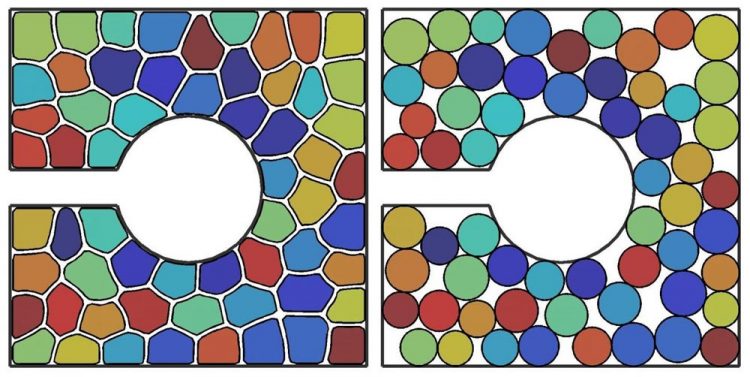CCNY-Yale researchers make shape shifting cell breakthrough

Deformable particles like cells can fill complex geometries more efficiently than fixed shapes like circles. With the new deformable particle model introduced by Shattuck and O'Hern, researchers can also simulate deformable systems more efficiently and accurately. Credit: Mark Shattuck, CCNY
Mark D. Shattuck, professor of physics at City College's Benjamin Levich Institute, and researchers at Yale developed the new efficient computational model. It allows simulated particles to realistically change shape while conserving volume during interactions with other particles. Their results appear in the latest edition of Physical Review Letters.
Developing computer simulations of particles, such as sand grains and ball bearings, is straightforward because they do not readily change shape. Doing the same for cells and other deformable particles is more difficult, and the computational models researchers currently use do not accurately capture how soft particles deform.
The computational model developed by Shattuck and lead investigator from Yale, Corey O'Hern, tracks points on the surfaces of polygonal cells. Each surface point moves independently, in accordance with its surroundings and neighboring particles, allowing the shape of the particle to change. It is more computationally demanding than current simulations, but necessary to correctly model particle deformation.
“We now have an efficient accurate computational model to investigate how discrete, deformable particles pack,” Shattuck said. It also allows researchers to easily adjust cell-cell interactions, consider directed motion, and can be used for both 2D and 3D systems.
One unexpected result from the model shows that deformable particles must deviate from a sphere by more than 15% to completely fill a space.
“In our new model, if no external pressure is applied to the system, the particles are spherical,” O'Hern said. “As the pressure is increased, the particles deform, increasing the fraction of space that they occupy. When the particles completely fill the space, they will be 15% deformed. Whether it's bubbles, droplets, or cells, it's a universal result for soft, particle systems.”
Among other applications, this technology may give researchers a new tool to examine how cancerous tumors metastasize. “We can now create realistic models of the packing of cells in tumors using computer simulations, and ask important questions such as whether a cell in a tumor needs to change its shape to become more capable of motion and eventually leave the tumor.”
Media Contact
All latest news from the category: Physics and Astronomy
This area deals with the fundamental laws and building blocks of nature and how they interact, the properties and the behavior of matter, and research into space and time and their structures.
innovations-report provides in-depth reports and articles on subjects such as astrophysics, laser technologies, nuclear, quantum, particle and solid-state physics, nanotechnologies, planetary research and findings (Mars, Venus) and developments related to the Hubble Telescope.
Newest articles

Superradiant atoms could push the boundaries of how precisely time can be measured
Superradiant atoms can help us measure time more precisely than ever. In a new study, researchers from the University of Copenhagen present a new method for measuring the time interval,…

Ion thermoelectric conversion devices for near room temperature
The electrode sheet of the thermoelectric device consists of ionic hydrogel, which is sandwiched between the electrodes to form, and the Prussian blue on the electrode undergoes a redox reaction…

Zap Energy achieves 37-million-degree temperatures in a compact device
New publication reports record electron temperatures for a small-scale, sheared-flow-stabilized Z-pinch fusion device. In the nine decades since humans first produced fusion reactions, only a few fusion technologies have demonstrated…





















